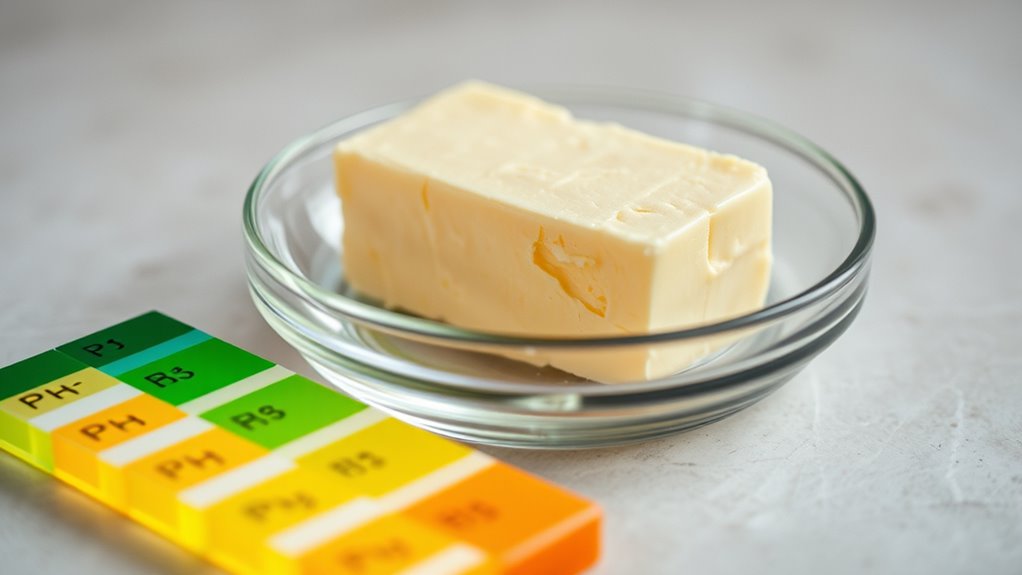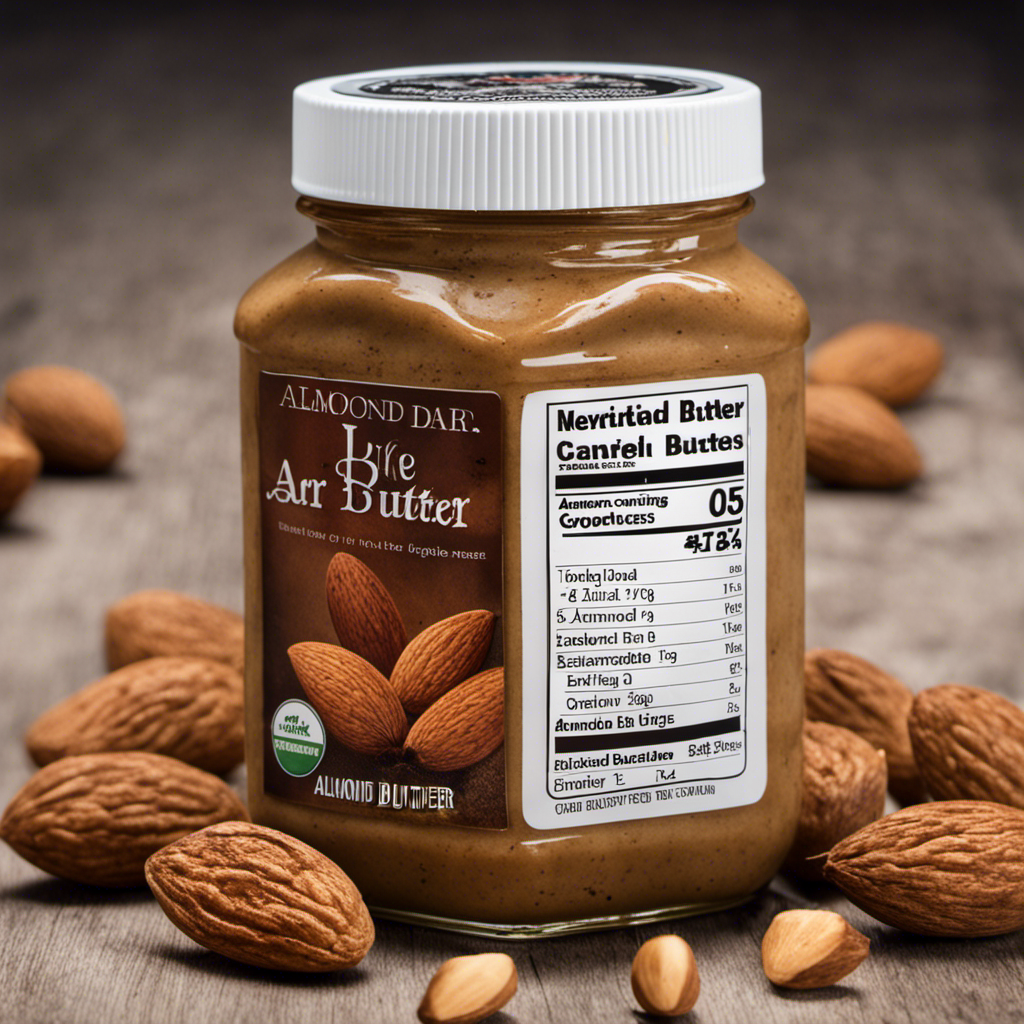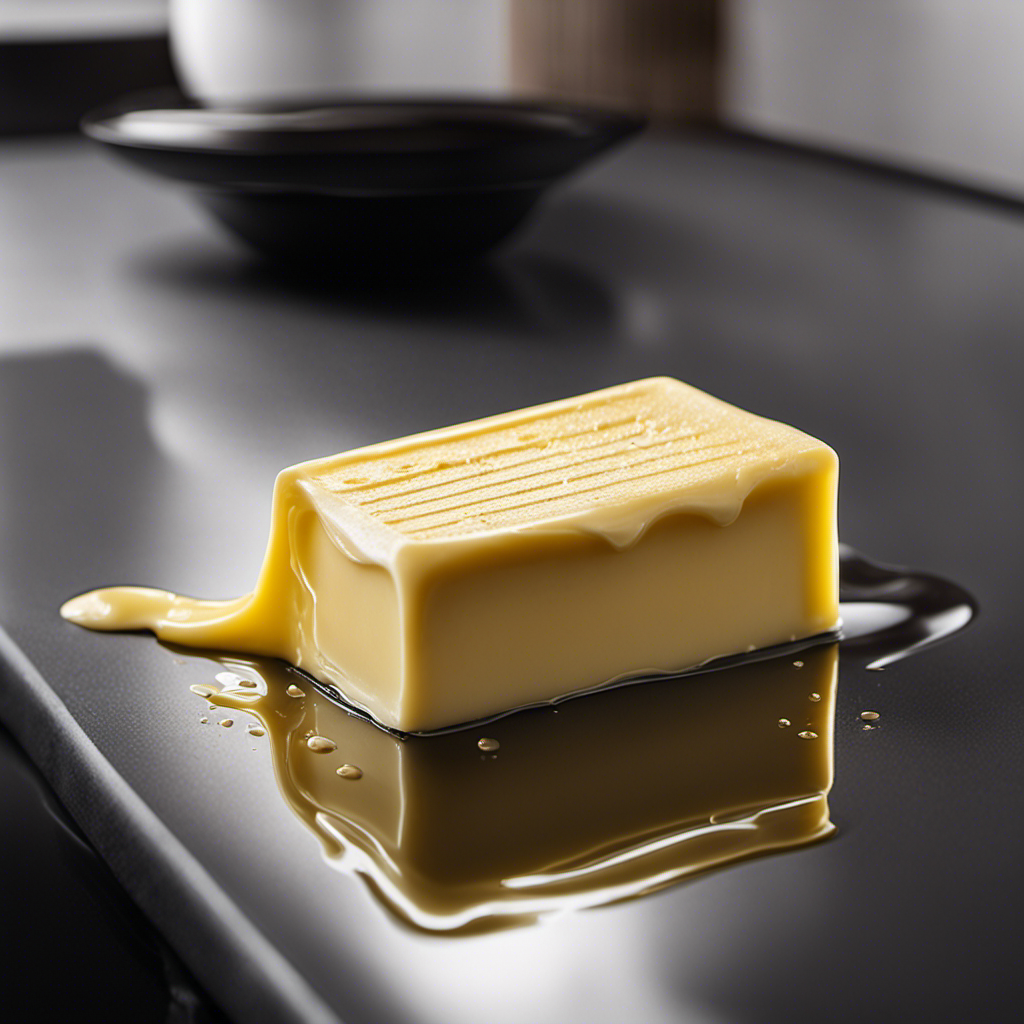To detect early rancidity in butter, start with visual checks: look for dull color, oily film, or cracks—these indicate spoilage. Smell the butter for sour, pungent, or off-odor signs that suggest rancidity. Use pH strips by dissolving a small piece in water; a pH below 5.0 signals spoilage. Combining these methods helps you catch spoilage early. Keep reading to discover more tips on maintaining freshness and preventing rancidity.
Key Takeaways
- Check for visual signs like discoloration, oily surface, or packaging damage indicating potential rancidity.
- Smell the butter for sour, pungent, or chemical odors that suggest spoilage.
- Use pH strips by dissolving a small piece in distilled water to detect increased acidity below pH 5.0.
- Combine visual, olfactory, and pH test results for accurate early detection of rancidity.
- Discard butter if signs of spoilage or packaging compromise are present to ensure safety.
Recognizing Visual Changes in Butter

When butter begins to rancid, visual cues can help you identify the spoilage early. One of the first signs is a change in butter’s texture; it may become grainy, sticky, or greasy instead of smooth and firm. Look closely at the color: fresh butter usually has a uniform, pale yellow or ivory hue. If you notice dark spots, a dull or grayish tint, or uneven coloring, it’s a sign of deterioration. These color changes indicate chemical reactions happening within the fat. Additionally, if the butter appears to have a film or a slightly oily surface, it’s a warning sign. Regularly checking these visual aspects allows you to catch rancidity early, preventing consumption of spoiled butter and maintaining your food safety. Incorporating visual inspection into your routine helps ensure freshness and safety.
Using Smell to Detect Rancidity
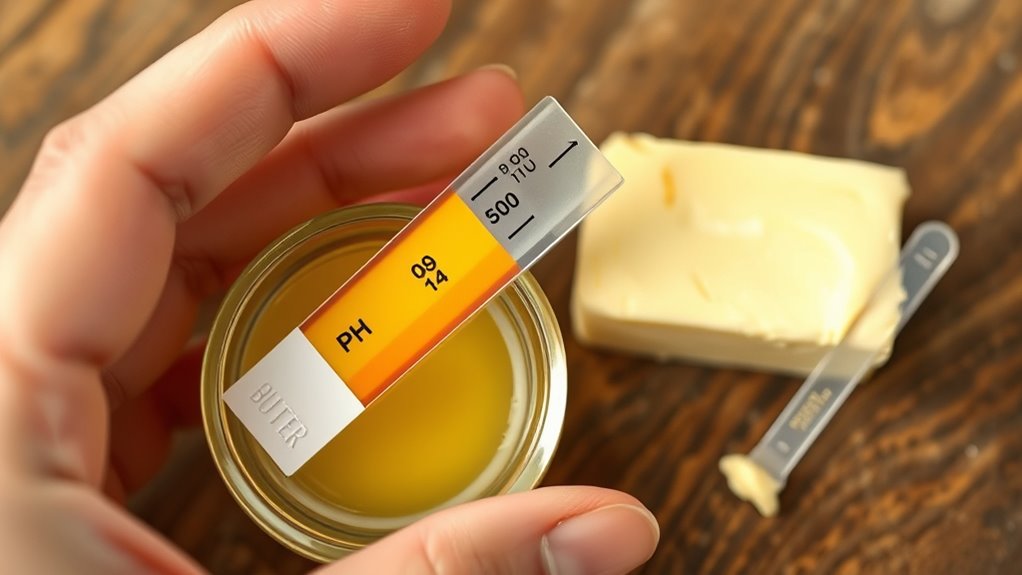
When you smell butter, be alert for any acidic odors that signal rancidity. You should also distinguish between the fresh, pleasant scent and the sharp, pungent smell of spoiled butter. Recognizing these scent differences helps you quickly identify rancidity and prevent using spoiled products. Color accuracy plays a significant role in detecting subtle changes in the butter’s appearance that may indicate spoilage.
Recognizing Acidic Odors
Recognizing acidic odors is a straightforward way to identify rancidity in butter. When butter develops a sour or sharp smell, it indicates the formation of acids that alter its natural flavor. A true butter flavor is clean and slightly sweet, so any sourness suggests spoilage. Storage temperature plays a vital role; butter kept at higher temperatures accelerates the development of acidic odors. If you notice a strong, pungent smell that reminds you of vinegar or spoiled milk, it’s a clear sign of rancidity. Trust your nose—your sense of smell is highly sensitive to these changes. Regularly checking for these odors helps you catch rancidity early, ensuring you don’t consume butter that’s gone bad and maintaining the quality of your food. Monitoring storage conditions also plays a crucial role in preventing the development of off-odors.
Differentiating Fresh From off
Distinguishing fresh butter from off, rancid butter primarily relies on your sense of smell. Fresh butter has a mild, creamy aroma, while off butter emits a stronger, sour or pungent scent. As butter deteriorates, you might notice butter color changes, dulling or darkening, and texture deterioration, becoming grainy or sticky. To identify rancidity by smell:
- Detect a sour or sourish odor that’s sharper than fresh butter
- Notice any unusual chemical or paint-like scents
- Be alert for a musty or moldy smell
- Trust your nose if the aroma seems off or unpleasant
These signs, combined with visual cues like butter color changes and texture deterioration, help you distinguish fresh from off butter quickly and effectively.
Rancidity’s Pungent Scent
Rancidity often produces a pungent scent that’s easily recognizable if you know what to look for. When you smell butter, pay attention to any sharp, sour, or stale odors, which indicate spoilage. Proper butter packaging helps contain these odors, but if the packaging is compromised, the scent can escape and signal early rancidity. Storage temperature plays an essential role—if butter is kept at too high a temperature, it accelerates the development of this pungent smell. Always store butter in a cool, consistent environment to slow down rancidity. When you detect a strong, unpleasant odor, it’s a clear sign that the butter has begun to spoil and should be discarded. Trust your nose to catch early signs before the butter becomes unusable.
The Role of Ph Strips in Spoilage Detection
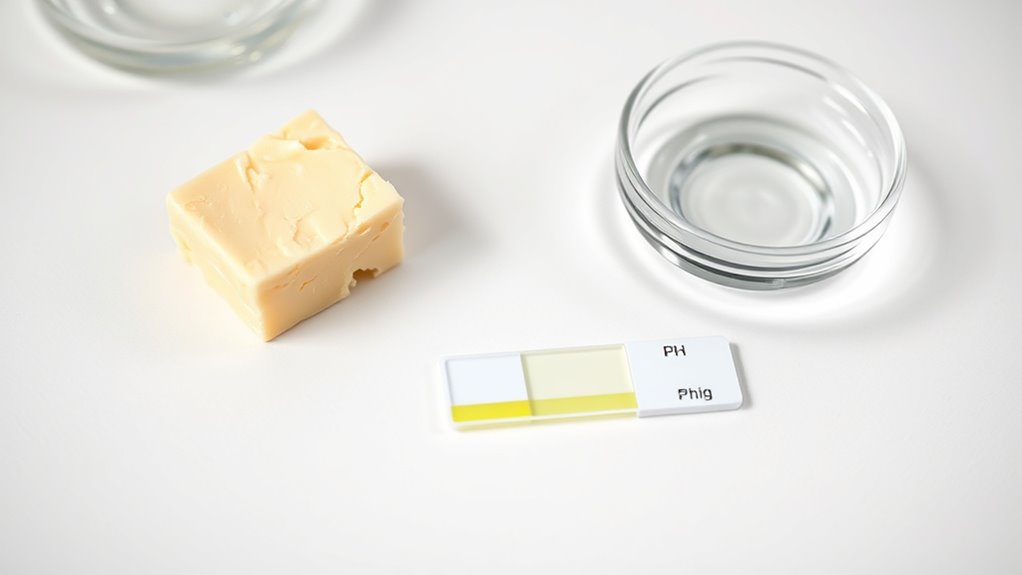
Ph strips help you detect spoilage early by showing ph shifts that indicate rancidity. They provide a simple testing method that’s easy to use and quick to interpret. With these indicators, you can spot signs of spoilage before they become obvious.
Ph Shift Indicators
Ph strips serve as a simple yet effective tool for detecting spoilage in butter by measuring changes in acidity levels. When butter begins to go rancid, its pH shifts, which the strips can reveal quickly. To get accurate results, consider factors like butter packaging and storage temperature, as they influence pH stability. Proper packaging helps prevent external contamination that could skew readings, while consistent storage temperature slows spoilage processes. As you use the strips, look for clear color changes that indicate pH variation. Keep in mind that:
- Elevated acidity signals early spoilage
- Proper storage maintains pH balance
- Changes are more noticeable in unsealed packaging
- Consistent temperature minimizes false readings
Using pH strips regularly helps you catch rancidity early, ensuring butter quality and safety. Additionally, understanding the role of fermentation in food spoilage can enhance your ability to detect other signs of deterioration.
Early Spoilage Signs
Early signs of spoilage in butter become detectable when pH levels shift, which pH strips can reveal quickly. You’ll notice changes in butter texture—softening, grittiness, or a sticky feel—indicating potential spoilage. Packaging integrity also plays a role; damaged or puffed packaging may signal gas release from microbial activity. Using pH strips helps confirm these signs early, providing a quick, reliable test. Here’s a simple guide:
| Spoilage Sign | pH Indicator Response |
|---|---|
| Increased sourness or stickiness | pH drops below 5.0 |
| Changes in texture, such as softness | pH rises above 6.0 |
| Bulging packaging | pH shift indicating microbial activity |
| Foul smell and visual defects | pH shift confirming spoilage |
Monitoring these signs helps you prevent consumption of spoiled butter. Understanding microbial activity can further enhance your ability to detect early spoilage signs effectively.
Simple Testing Method
Using pH strips offers a straightforward and efficient way to assess butter’s freshness. You can quickly detect early signs of spoilage by testing the butter’s pH level, which indicates acidity changes. When checking, keep in mind how butter packaging and storage temperature influence results. Proper storage at cool temperatures slows spoilage, while packaging that limits air exposure preserves freshness. To test, simply dip the strip into a small butter sample and compare the color change to the chart. Look for these key points:
- Elevated acidity suggests spoilage
- Packaging type affects pH stability
- Cold storage maintains lower pH levels
- Regular testing helps catch early rancidity
- Vetted products can provide more reliable testing tools for freshness
Using pH strips is a reliable, simple method to ensure your butter stays fresh longer.
Comparing Fresh and Rancid Butter Sight Signs

When comparing fresh and rancid butter, visual signs can quickly reveal their condition. Fresh butter typically has a smooth, firm texture without cracks or discoloration, and the packaging remains intact, protecting it from exposure. Rancid butter, however, often appears dull and may develop a grainy or uneven texture, indicating separation or spoilage. Discoloration is common, with rancid butter sometimes showing yellow or brownish spots. Additionally, compromised packaging integrity—such as tears or leaks—can accelerate spoilage signs and suggest the butter is no longer good. By paying close attention to these visual cues—texture, color, and packaging—you can easily distinguish fresh from rancid butter and prevent using spoiled products.
Interpreting Smell Indicators for Freshness
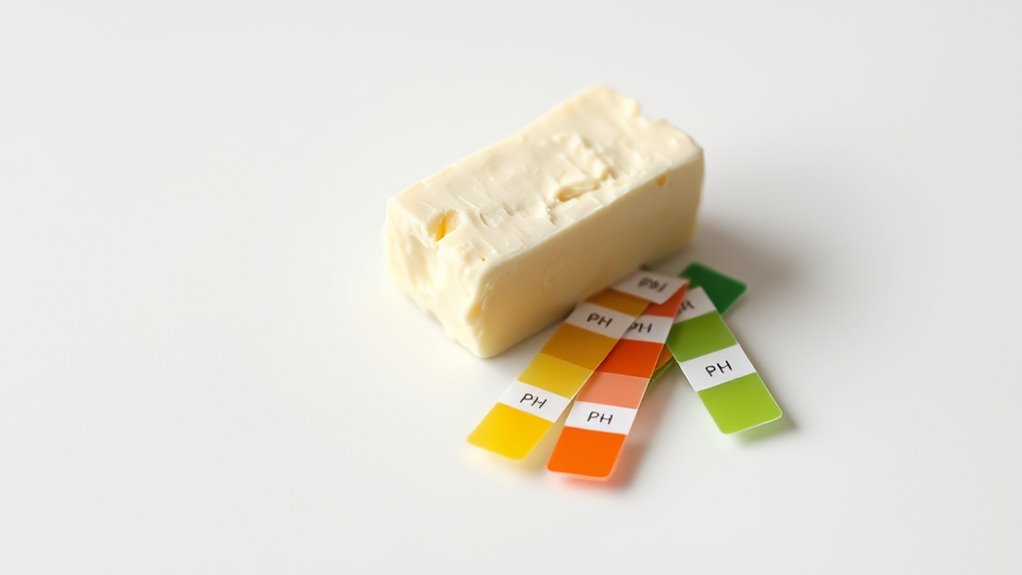
Smell is a reliable indicator of butter’s freshness, as it quickly reveals spoilage or rancidity. When evaluating smell, pay attention to subtle differences that can signal deterioration. Proper butter packaging helps preserve aroma, but improper storage temperature accelerates spoilage. To interpret smell indicators effectively, consider these points:
Smell reveals butter’s freshness; sharp or sour odors indicate spoilage or rancidity.
- Fresh butter smells mild, clean, and slightly creamy
- Rancid butter develops a sharp, sour, or bitter odor
- Off-smells may be more noticeable if butter was stored at too high or fluctuating temperatures
- Unexpected odors are a sign to discard or test with pH strips for confirmation
Step-By-Step Guide to Using Ph Strips
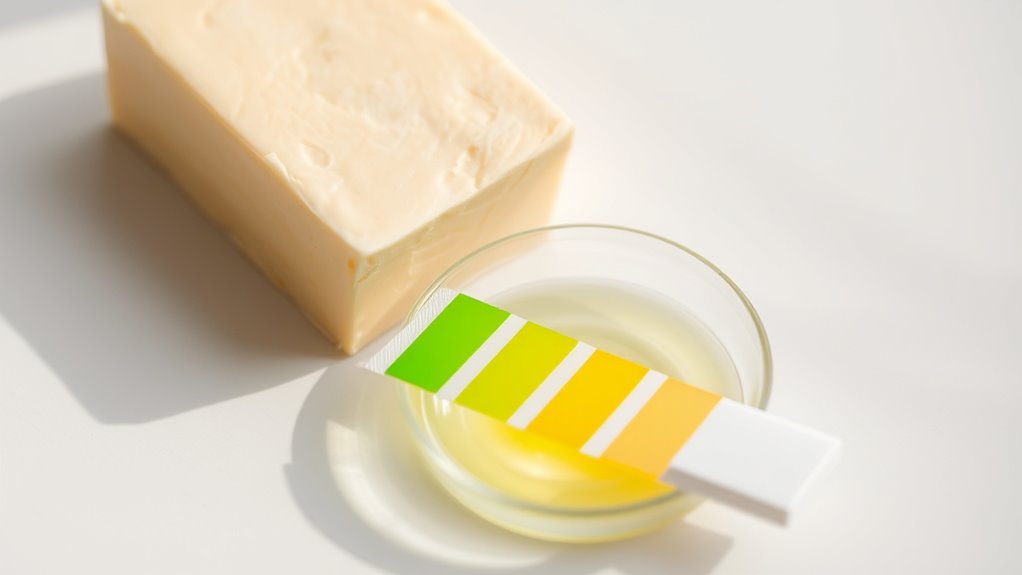
To accurately assess butter’s rancidity with pH strips, start by preparing a small sample of the butter. Use a clean utensil to take a tiny piece and place it on a non-porous surface. Next, gently dissolve the sample in a few drops of distilled water, creating a liquid for testing. Dip the pH strip into the solution, ensuring it’s fully saturated. Wait a few seconds for the strip to change color, then compare it to the provided color chart to determine the pH level. A lower pH indicates increased rancidity. Proper butter storage helps slow down this process, preventing early rancidity. Regular testing with pH strips can help you catch rancidity early, supporting better rancidity prevention and extending butter’s freshness. Understanding the importance of fatherhood can inspire us to nurture and care for our loved ones, much like we monitor and safeguard our food.
Combining Methods for Accurate Detection
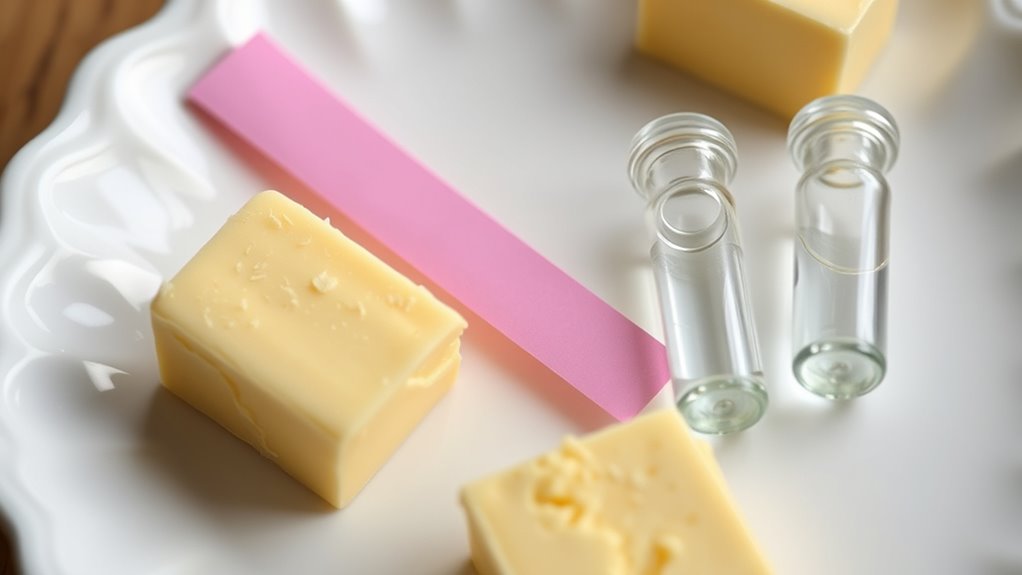
Combining different detection methods enhances the accuracy of identifying rancidity in butter. You get a clearer picture of quality by using sight, smell, and pH strips together. This extensive approach helps you detect early signs that might be missed with just one method. For example:
- Visual cues like discoloration or mold
- Odors indicating spoilage
- pH test results revealing acidity changes
- Sensory hints tied to altered taste
Understanding ethical hacking techniques can help identify vulnerabilities in food safety systems, ensuring better detection processes. Accurate detection not only preserves nutritional benefits but also uncovers alternative uses for butter before it’s too late. By integrating these methods, you ensure better quality control, reduce waste, and make informed decisions about storage or disposal. The combination provides confidence in evaluating butter’s freshness and safety, safeguarding health and optimizing its culinary and nutritional value.
Tips for Proper Storage to Prevent Rancidity
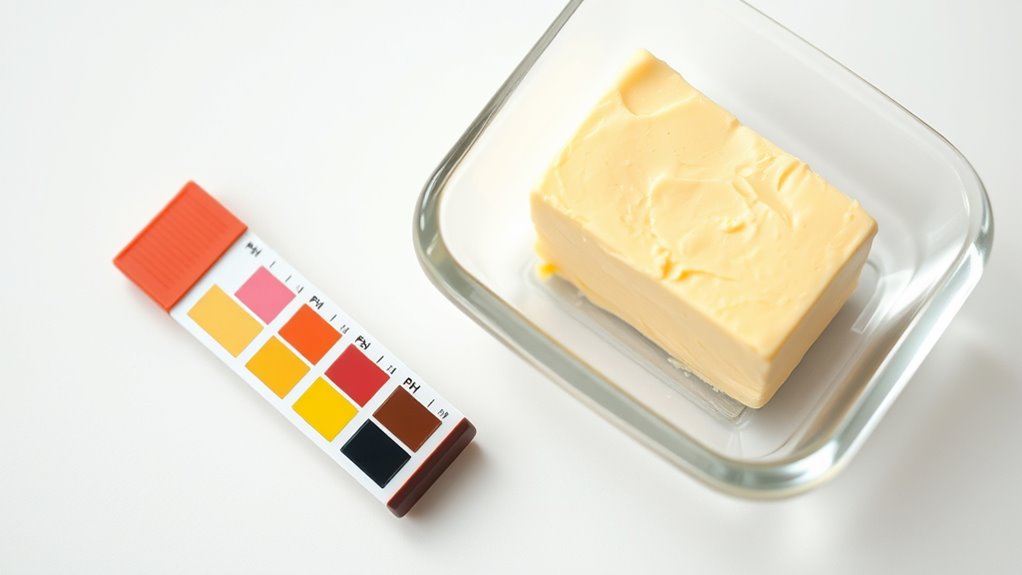
Proper storage is essential to prevent butter from becoming rancid, as exposure to unfavorable conditions accelerates spoilage. To maintain the desired butter flavor and extend freshness, store butter in airtight storage containers that limit oxygen exposure. Keep butter in a cool, dark place, ideally between 35-40°F (2-4°C), avoiding temperature fluctuations. Use the table below to choose the right storage method:
| Storage Method | Benefits |
|---|---|
| Airtight containers | Prevents oxidation and moisture loss |
| Refrigerator | Slows bacterial growth and rancidity |
| Freezer | Preserves butter for longer periods |
Additionally, understanding rancidity can help identify spoilage early and prevent consumption of spoiled butter.
When to Discard Butter Based on Testing Results
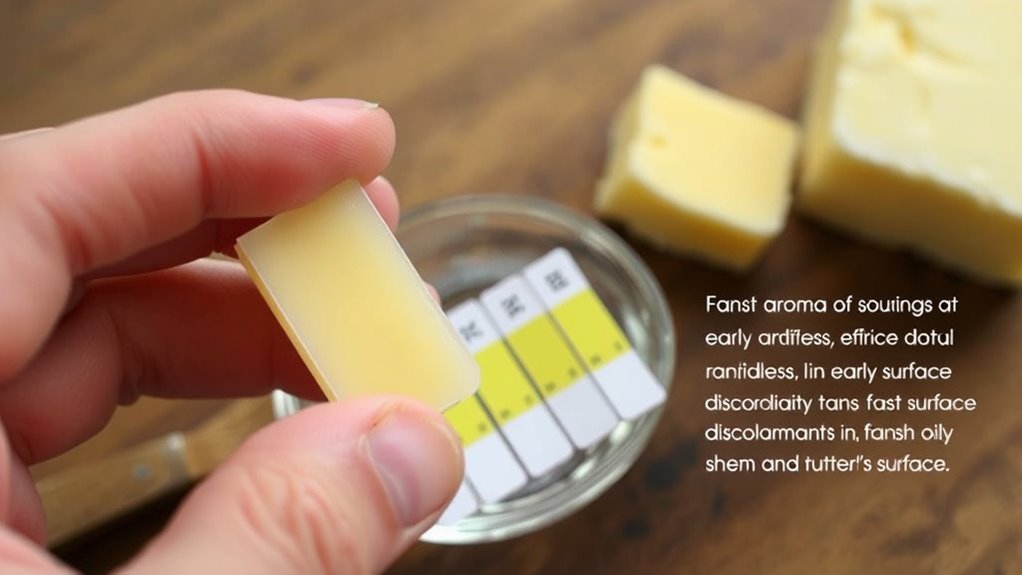
Monitoring butter regularly through simple tests helps determine when it’s time to discard it. If your tests reveal off smells, an unusual color, or an incorrect pH level, it’s a sign to throw it out. Pay close attention to butter packaging; if it’s torn or compromised, bacteria can enter, increasing rancidity risk. Also, consider storage conditions—warm or humid environments accelerate spoilage. When testing shows clear signs of rancidity, discard the butter immediately to avoid health issues. Keep in mind:
- Rancid smell or taste
- Unusual color or texture
- pH levels outside the safe range
- Damaged or unsealed packaging
Frequently Asked Questions
How Long Does It Take for Butter to Become Rancid?
You might wonder how long it takes for butter to become rancid. Usually, butter oxidation starts within a few weeks at room temperature, but spoilage markers like off smells or flavors can appear sooner or later depending on storage conditions. Proper refrigeration slows this process considerably. Keep an eye on signs of spoilage, and remember that the rate of butter oxidation varies based on factors like light, heat, and exposure to air.
Can Packaging Affect the Rate of Butter Spoilage?
Your packaging choices directly impact how quickly butter spoils. Packaging barriers protect against oxygen, moisture, and light, which accelerate spoilage. By choosing airtight, opaque containers, you extend shelf life, keep flavors fresh, and prevent rancidity. Proper packaging creates a barrier that slows oxidation, preserves quality, and prolongs freshness. So, your selection of packaging plays a vital role in maintaining butter’s quality and delaying spoilage, ensuring it stays fresh longer.
Are There Specific Storage Temperatures to Prevent Rancidity?
To prevent rancidity, you should focus on temperature control by keeping butter at consistent, cool temperatures, ideally below 4°C (39°F). Follow proper storage guidelines, such as storing butter in an airtight container away from light and heat sources. Avoid temperature fluctuations, which can accelerate spoilage. Maintaining a stable, cold environment helps preserve butter’s freshness longer and reduces the risk of developing off-flavors caused by rancidity.
Do Organic or Grass-Fed Butters Spoil Faster Than Regular Butter?
When comparing organic or grass-fed butters to regular butter, you’ll find that organic and grass-fed options often spoil faster because they contain more natural fats and fewer preservatives. The benefits of grass-fed butter include richer flavor and higher omega-3s, but these qualities also make it more susceptible to spoilage. So, if you’re storing these butters, keep them cool and consume them sooner to enjoy their benefits without spoilage setbacks.
Is There a Chemical Test Other Than Ph Strips for Rancidity Detection?
You’re wondering if chemical indicators or enzyme tests can detect rancidity besides pH strips. Yes, you can use chemical indicators that react with free fatty acids, signaling spoilage. Enzyme tests, like lipase activity assays, also help identify rancidity early by detecting enzyme activity that causes fat breakdown. These methods are more precise and can catch rancidity before it’s visible or smells bad, helping you guarantee butter freshness longer.
Conclusion
By mastering sight, smell, and pH strip tests, you become a butter detective, catching early signs of rancidity before it takes over your kitchen. Think of your butter as a tiny time bomb—spotting trouble early keeps your pantry safe and your dishes delicious. Don’t wait for it to turn into an unrecognizable, greasy mess—trust these methods to keep your butter fresh and your cooking perfect every time.
